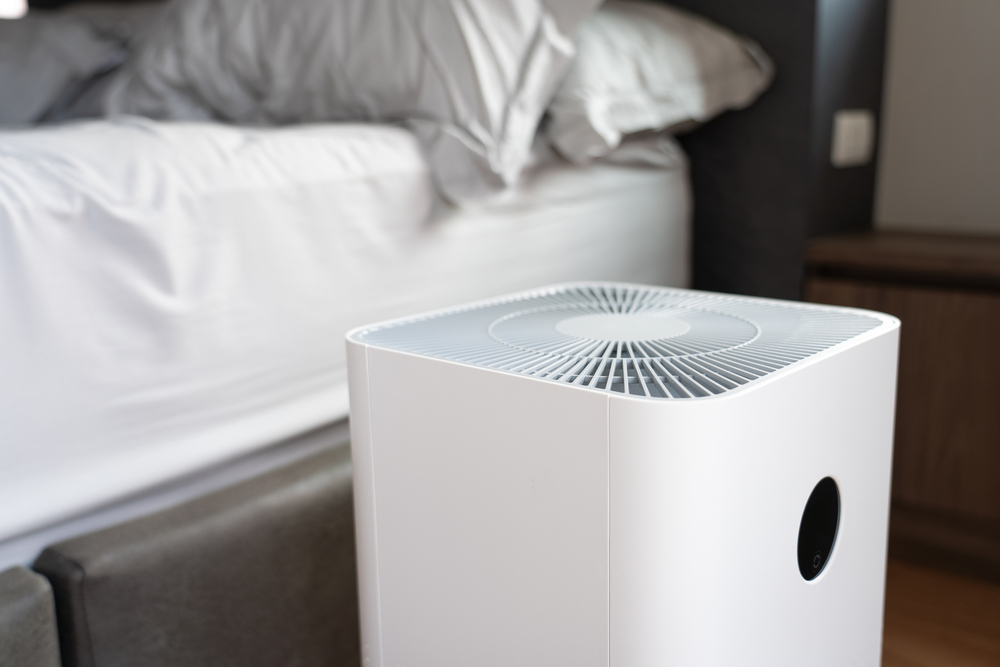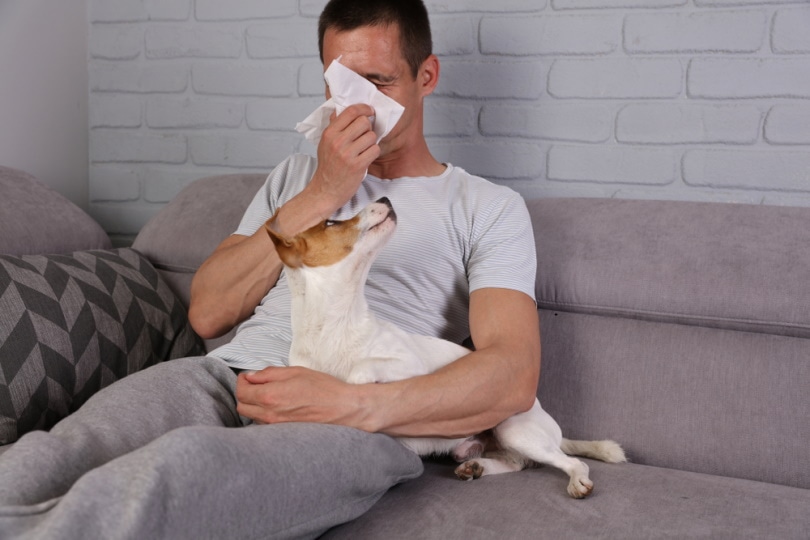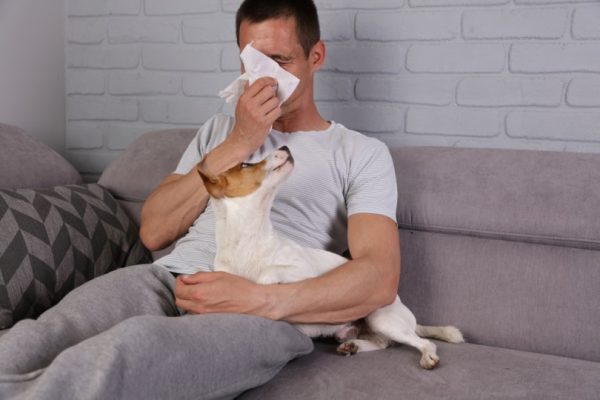Approximately 10 to 20 percent1 of humans worldwide suffer from dog or cat allergies. For animal lovers, an allergy to your favorite pet can be devastating. Allergies can be quite debilitating, but with the advancement of modern medicine, more and more can be done to combat those pesky allergies.
If you are a dog lover who suffers from a dog allergy2, you may wonder if there is anything you can do to build immunity to the allergy to make life with your dog that much more comfortable. The good news is that some things can be done to help you build immunity. There are also some other suggestions to help relieve the allergies. Let’s take a look.
What Causes Dog Allergies?
Allergies are the reaction that takes place when the body’s immune system reacts to a form of allergen. With dog allergies, the reaction is typically due to certain proteins found mostly in oil secretions from a dog’s skin and, more commonly, in the saliva.
It is a common misconception that the allergy is to the dog’s hair. Saliva, skin flakes, or dander cause the allergy. The proteins from these allergens are then carried into the environment and lead to an allergic reaction. Allergies are not a one-size-fits-all kind of condition either; everyone has different levels of severity and can exhibit different symptoms.

How Does the Allergy Develop?
Allergies can develop at any age. The immune system will create antibodies naturally programmed to recognize and respond to a specific allergen. Even if you have been around an allergen without issues, an allergy can still potentially develop.
While you cannot inherit a specific allergen, the likelihood of allergies is much greater if allergies run in the family. Occasionally, severe allergies can develop into allergic asthma, triggered by exposure to allergens.
- Sneezing
- Runny nose
- Itchy, red, or watery eyes
- Nasal congestion
- Itchiness in the nose and roof of the mouth
- Postnasal drip
- Cough
- Trouble sleeping
- Facial pressure or pain
- Swelling and blue-colored skin under the eyes
- Difficulty breathing
- Chest tightness
- Chest pain
- Shortness of breath, coughing or wheezing
- A whistling or wheezing sound when exhaling
- Trouble sleeping caused by shortness of breath, coughing, or wheezing

Is There a Cure for Allergies?
Unfortunately, there is no cure for allergies. Symptoms of allergies can be controlled through a variety of measures, including medication, avoiding allergens, and even immunotherapy in some cases. Allergies can be a bit unpredictable at times. Some people even outgrow them as they age, while others experience worsening symptoms. The best thing to do for your allergies is to speak with your allergy specialist and come up with a game plan.
Can You Build Up an Immunity to Allergies?
You can work to build immunity to dog allergies through immunotherapy. For allergies, this means getting allergy shots to help build up this immunity to the allergens by increasing the dose triggers over time.
This is a common go-to for pet lovers desperate to keep their pets and continue to live among them. Immunotherapy is not a quick solution and is more of a long-term solution that helps build a tolerance to the allergen(s) over time.
Aside from shots, there are allergy drops available for those who would prefer to steer clear of needles. The drops are not nearly as effective as the shots in the long run but are beneficial to those who would refuse immunotherapy due to the shots themselves.

How to Reduce Dog Allergens
All hope is not lost if you are a dog owner who suffers from a dreaded dog allergy. Here are some additional tips on how you can help reduce allergens in the home.
1. Keep Clean and Tidy
If you suffer from dog allergies but still share a home with dogs, you must keep up with regular cleaning to reduce your exposure to the allergen. Make sure you thoroughly vacuum carpets and furniture at least once a day and keep surfaces wiped down.
2. Keep Up With Laundry
Make sure you wash laundry regularly, especially any bedding that your dog lays on. The dander can get on clothes and is all over bedding, making them a potential trigger. Keeping up with regular washing will help reduce the amount of dander on the fabrics.
3. Replace Carpets with Hard Flooring
While this may be an expensive option that can take quite a bit of hard work if you don’t hire out the job, replacing the carpets in the home with hard flooring is a good idea. Allergens tend to get trapped in the fabrics of carpet and can cause allergy sufferers to suffer that much more. Hard surfaces don’t trap the allergens and are much easier to clean. If that’s not a possibility, try utilizing a carpet cleaner and using it regularly.
4. Ditch the Upholstered Furniture
Just like carpets, upholstered furniture also hangs on to dander and allergens. It can be much more beneficial to get some leather or faux leather furniture that is easy to clean off and won’t trap those triggers. Another perk? You won’t have to vacuum the furniture nearly as much.
5. Use HEPA Filters and Air Purifiers
There are some pretty effective air filters and air purifying machines on the market today. Make sure you use high-quality HEPA filters in the ducts to help filter those particles and keep them from being circulated throughout the house. You can also buy an air purifier for specific rooms to help keep the air clean and low in allergens.

6. Set Boundaries
You may have to set certain boundaries within the home to ensure your dog is not frequenting areas of the allergy sufferer. It is best to keep the dog(s) out of the bedroom of anyone that suffers from allergies. If that’s not going to be feasible, at least set furniture boundaries to keep them from the areas the sufferer frequently sits or sleeps.
Conclusion
Dogs are an absolute joy to have around, but for those that suffer from dog allergies, it’s a bit of a double-edged sword. You can build up an immunity to dog allergies with the use of immunotherapy, which is usually in the form of injections or drops. There are some other steps you can take in terms of treating the allergy symptoms and working to reduce exposure in the home. Of course, it’s best to always consult with your healthcare practitioner for the best information on how to handle your allergy.
Featured Image Credit: Albina Gavrilovic, Shutterstock
Contents
- What Causes Dog Allergies?
- How Does the Allergy Develop?
- Is There a Cure for Allergies?
- Can You Build Up an Immunity to Allergies?
- How to Reduce Dog Allergens
- 1. Keep Clean and Tidy
- 2. Keep Up With Laundry
- 3. Replace Carpets with Hard Flooring
- 4. Ditch the Upholstered Furniture
- 5. Use HEPA Filters and Air Purifiers
- 6. Set Boundaries
- Conclusion












